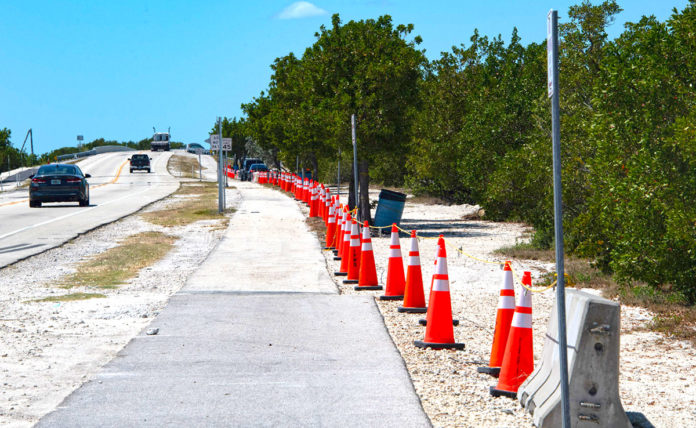
Guardrail, delineated parking with declaration lanes and kayak launches are among the items within the village’s proposed plan for a scenic yet dangerous stretch of road that connects Upper Matecumbe and Lower Matecumbe Keys.
A.J. Engelmeyer, village public works director, discussed the plan for the area known as the Fills during the June 2 meeting of the Islamorada Village Council. Engelmeyer said it’s a “less is more” approach. Per the plan, shared use paths for bikers and pedestrians would move away from the highway on the islands that make up the Fills, Lignumvitae Key, Tea Table Relief and Indian Key Fill. Guardrails would be placed along both sides of the highway to provide a barrier between those who use the path and vehicles. It would prevent vehicles from illegally parking.
In addition, the Fills would become a no-passing zone and a no-swim zone.
On Indian Key Fill, Engelmeyer said, the plan proposes closing access to the boat ramp area on the southern end and keeping access on the northern end.
“This gives more of an area for queuing boats that pull in so they’re not waiting to turn off U.S. 1 if the boat ramp is backed up a little bit,” he said.
As for a boat ramp, Engelmeyer said they’re proposing to re-establish the former boat ramp that’s been out of service for many years and trimming mangroves in that area.
“If you’re launching in the current water access that’s there, you’re launching into an active channel. We feel it’s pretty unsafe to do that,” Engelmeyer said. “So we’re hoping that both FDOT (Florida Department of Transportation) and FDEP (Florida Department of Environmental Protection), will agree with us and look at moving to the existing boat ramp that was there many many years ago,” Engelmeyer said.
The current water access point at the launch on Indian Key would be used for kayaks.
A kayak launch and the addition of turn lanes are proposed on the north end of Tea Table Relief. On the south end, the bike path would be shifted farther from U.S. 1. Engelmeyer said there are revegetation zones for mitigation if and when the village is able to replace the boat ramp.
Mayor Pete Bacheler aided in the development of the plan. He said it’s nothing more than guardrails, parking for roughly 40 cars for a set period and no-parking signs.
“We’re not going to have any bathrooms. We’re not going to allow people to stay down there too long. We’re not going to allow tents. We’re not going to allow barbecuing. … none of that,” he said.
Councilman Henry Rosenthal inquired into the cost of the improvements and specifically who’d be paying for it. Engelmeyer said the village would seek grants for the Florida Department of Transportation. Rosenthal said his position surrounded beautification of the Fills and didn’t believe guardrails contribute to that idea.
“I’m very much against guardrails … very much against it,” he said. “We have hedges all over Islamorada. I don’t see anybody driving through those hedges. I really question this project in its entirety. All we have to do is maintain it and that’s it.”
Engelmeyer said village staff does a great job addressing those who illegally park on the Fills. He added that 70-plus tickets were handed out to the nonresponsive people who “blow you off.”
Councilman David Webb said he’s sure FDOT indicated to the village that guardrails are necessary because pedestrians and bike trails are close to the highway. Besides pedestrian safety, he said, it delineates, similar to the swim zone the village placed at White Marlin Beach and Port Antigua beach on Lower Matecumbe.
“There’s clear delineation that you’re not supposed to go across the line. We don’t have huge law enforcement issues at Port Antigua because they (boats) know with certainty that if they go inside that very visible buoy they’ll be talked to by law enforcement,” he said.
“This is not just one thing,” he continued. “You can’t just put up no-parking signs, walk away and expect every single person to comply with the no-parking zone. The reason why there’s so much compliance isn’t because of the signs, it’s because we’re paying overtime to have staff down there (at the Fills).”
Discussion surrounding the Fills goes back several years as residents voiced displeasure over the crowding, trashing and safety issues seen during holidays and busy weekends. A place once packed with daytrippers is now an area with limited parking and a line of cones to prevent illegal parking. It’s all due to a sublease the village secured in 2019 for property owned by Florida Department of Transportation and Department of Environmental Protection.
By 2020, measures were taken to reduce parking space on the Fills. Barricades and orange cones still remain. A launch on Indian Key remains closed.
Cheryl Meads was a councilwoman during the time the village eyed a sublease for state property since FDOT wasn’t controlling daytrippers. She said nothing in the contract was required except permission if the village was seeking to do something on the Fills.
“The master plan was not necessary,” she said. “The question is what is it the community wants? What you hear overwhelmingly is they want no-parking signs and nothing else. We don’t need guardrails. FDOT didn’t put up guardrails. They aren’t required.”
A survey conducted by consultant CPH Inc. found that 60% of respondents were opposed to the idea of bringing active recreation, like boat and kayak access, to Indian Key Fill. Roughly 52% said they’re strongly opposed to restroom facilities on the Fills. Many also strongly agreed on a swim ban along the Fills, as well as no-wake zones.
Bacheler said the budget would go up $150,000 to $200,000 if the village keeps paying staff overtime to maintain the Fills without making changes.
“This council has a fiscal responsibility to be careful with our budget and to not waste the money of taxpayers sitting there in front of us,” he said. “The bottom line is safety and money. We’re going in the right direction and these are good changes to make. I wouldn’t support anything less than what we got.”






















